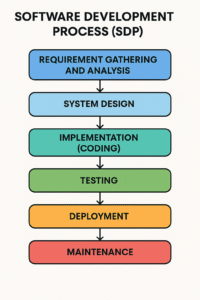Software Development Process (SDP)
Introduction
The Software Development Process (SDP) is the step-by-step method followed to create high-quality software. It ensures that the software is developed in a planned, organized, and controlled manner. The process includes everything from understanding user needs to final delivery and maintenance.
What is the Software Development Process (SDP)?
The Software Development Process is a set of activities used to create software efficiently. It defines how to move from requirements to code, and from testing to release, in a systematic way. It is also called the Software Development Life Cycle (SDLC).
Phases of the Software Development Process
-
Requirement Gathering and Analysis
-
Understanding what the user needs.
-
Creating a Software Requirement Specification (SRS) document.
-
-
System Design
-
Designing software architecture, database, and user interface.
-
Helps plan how the software will work internally and externally.
-
-
Implementation (Coding)
-
Actual programming is done here using a suitable language like Python, Java, etc.
-
-
Testing
-
Ensures that the software works correctly and is bug-free.
-
Types include unit testing, integration testing, and system testing.
-
-
Deployment
-
Making the software available to users.
-
It may be released as a whole or in stages.
-
-
Maintenance
-
Fixing bugs, updating features, and improving performance after release.
-

Importance of SDP
-
Ensures high-quality software.
-
Saves time and cost through better planning.
-
Improves team collaboration and productivity.
-
Helps detect errors early.
-
Ensures software meets user needs and expectations.